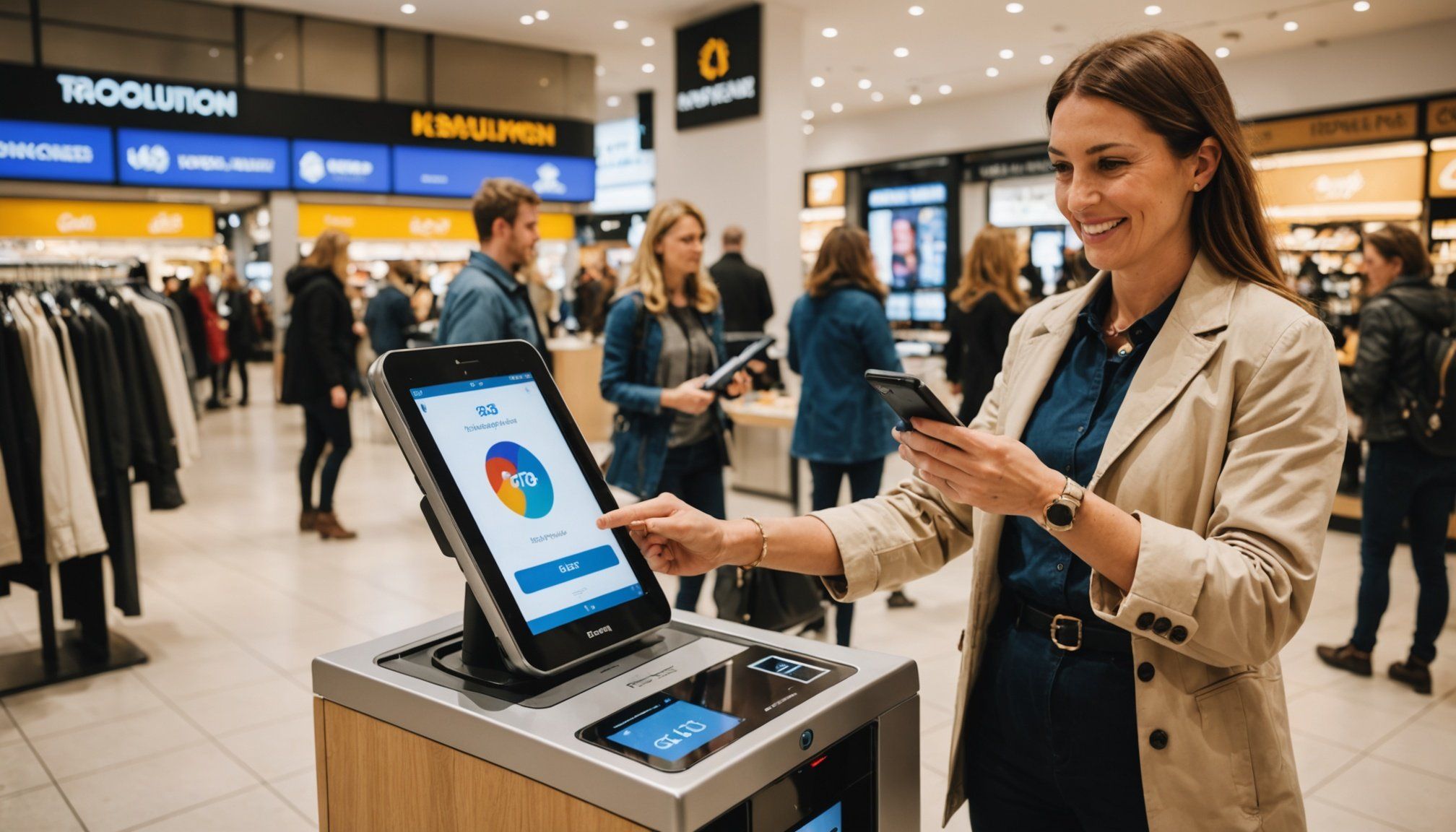Revolutionizing Retail: Innovative Contactless Shopping Solutions to Enhance Customer Safety in the UK
The retail landscape in the UK is undergoing a significant transformation, driven by the adoption of innovative contactless shopping solutions. These advancements are not only enhancing customer safety but also revolutionizing the shopping experience, making it more convenient, secure, and personalized.
The Rise of Contactless Payments
Contactless payments have become a cornerstone of UK retail, with their use surging dramatically in recent years. This shift has been accelerated by the pandemic, which highlighted the importance of hygiene and touch-free transactions.
In the same genre : Unlocking Visitor Engagement: 10 Innovative Strategies for UK Museums to Boost Growth and Discover New Opportunities
How Contactless Payments Work
Contactless payment systems utilize Near Field Communication (NFC) technology, allowing customers to make payments by simply tapping their card or smartphone on a payment terminal. Here are some key benefits of contactless payments:
| Benefit | Description |
|---|---|
| Convenience | Faster checkout times, reducing the time spent at the till |
| Hygiene | No physical contact required, making it a safer option |
| Security | Secure transactions, often requiring a PIN for higher value purchases |
For instance, during the pandemic, retailers quickly adapted by increasing contactless spending limits and introducing payment terminals that support mobile wallets. This change reduced bottlenecks at tills and improved the overall shopping experience[1][2].
Have you seen this : Proven Tactics for UK Startups to Secure Venture Capital Funding
Enhancing Customer Experience with Mobile Payments
Mobile payments have further expanded the possibilities of contactless transactions. Systems like Apple Pay and Google Wallet allow shoppers to pay directly with their smartphones or wearable devices, eliminating the need to carry physical cards.
The Impact of Mobile Payments
Mobile payments are not just convenient; they also offer a seamless integration with other retail technologies. Here are some ways mobile payments are enhancing the shopping experience:
- Convenience: Mobile payments are quick and easy, allowing customers to make transactions without the need for physical cards or cash.
- Security: Mobile payments are secure, often requiring biometric authentication or PINs to complete transactions.
- Personalization: Mobile wallets can be linked to customer accounts, enabling personalized shopping experiences, such as instant rewards and tailored promotions[1][5].
For example, grocery software is now optimized to support mobile payments, minimizing customer waiting time and enhancing customer satisfaction levels. This integration allows customers to complete purchases via their mobile phones, using applications like Apple Pay or Google Wallet, making the shopping experience more efficient and enjoyable[5].
Integration of Loyalty and Reward Programs
Retailers are innovating in other areas as well, particularly with loyalty and reward programs. By linking payment methods to customer accounts, businesses are creating more personalized shopping experiences.
How Loyalty Programs Work
Here are some ways loyalty programs are integrated with payment systems:
- Personalized Benefits: Customers can earn points, receive discounts, or unlock special offers simply by using their preferred payment option.
- Tokenized Rewards: Some businesses are experimenting with blockchain-based loyalty schemes, allowing points or rewards to be tokenized and used across multiple retailers.
- Customer Insights: The ability to track customer behavior through these systems provides valuable insights, enabling retailers to refine their offerings and create more effective marketing campaigns[1].
For instance, linking payment methods to customer accounts simplifies the shopping journey. A single transaction can trigger multiple benefits, from instant rewards to tailored promotions, encouraging repeat business and strengthening brand loyalty[1].
Click and Collect Services: Enhancing Customer Convenience
Click and collect services have become increasingly popular, allowing customers to order online and collect their purchases in-store. This service enhances customer convenience and safety.
Benefits of Click and Collect
Here are the key benefits of click and collect services:
| Benefit | Description |
|---|---|
| Convenience | Customers can order at their convenience and collect at a time that suits them |
| Safety | Reduces the need for physical contact during delivery |
| Efficiency | Streamlines the shopping process, reducing wait times |
Click and collect services not only make the shopping process more efficient but also reduce the risk of physical contact during delivery. This has been particularly beneficial during the pandemic, where minimizing contact was crucial for public health[2].
Self-Service Checkout Systems: Improving Customer Satisfaction
Self-service checkout systems are another innovation that retailers are implementing to improve customer satisfaction and safety.
How Self-Service Checkouts Work
Here are some key features of self-service checkout systems:
| Feature | Description |
|---|---|
| Contactless Payment | Integrated contactless payment options, making the process quicker and safer |
| Inventory Management | Real-time inventory tracking, ensuring accurate stock levels |
| Customer Feedback | Immediate feedback mechanisms to help improve the shopping experience |
Self-service checkouts with integrated contactless payment options make the process even quicker and safer. These systems also help in real-time inventory management and provide immediate feedback mechanisms to continuously improve the shopping experience[2].
The Role of AI and Biometric Payments
As technology advances, the retail sector is exploring new ways to innovate. AI-powered solutions and biometric payments are being trialled in some stores, promising even faster and more secure transactions.
AI-Powered Chatbots
AI-powered chatbots are being adopted to improve the customer experience. These chatbots can handle a variety of tasks, from answering customer inquiries to providing personalized product recommendations.
For example, Dan Hardy, Group Managing Director at ASEL, emphasizes the importance of authenticity and transparency in customer service: “Authenticity and transparency are vital to success. Our main objective is to always act with sincerity and integrity to provide a genuinely collaborative service, which customers can trust and believe in.”[2]
Biometric Payments
Biometric payments, such as fingerprint or facial recognition systems, are being trialled to offer even faster and more secure transactions. These systems promise to enhance security and convenience, making the shopping experience more seamless.
The Future of Retail Payments
As technology continues to evolve, the retail sector is poised for further transformation. Here are some trends that are likely to shape the future of retail payments:
- Cryptocurrencies: Cryptocurrencies are expected to play a bigger role as their adoption grows. Digital currencies like Bitcoin and Ethereum offer decentralized payment solutions, allowing consumers to make purchases without relying on traditional banking systems[1].
- Unified Commerce Solutions: Companies like Puma are partnering with unified commerce specialists like Sitoo to enable a seamless global shopping experience. This integration simplifies processes, integrates physical and digital commerce, and enables store associates to provide the best possible customer service[3].
- Advanced Payment Solutions: Innovations like SoftPos by PXP Financial allow merchants to accept contactless payments directly on Android devices, eliminating the need for additional hardware. This is a cost-effective and scalable solution that expands payment options via a secure and flexible method[4].
Practical Insights and Actionable Advice
For retailers looking to adopt these innovative contactless shopping solutions, here are some practical insights and actionable advice:
- Invest in NFC Technology: Ensure that your payment terminals support NFC technology to facilitate contactless payments.
- Implement Mobile Payment Solutions: Integrate mobile payment systems like Apple Pay and Google Wallet to offer customers a seamless and convenient payment experience.
- Focus on Customer Data: Use customer data to provide personalized experiences and enhance customer satisfaction.
- Train Staff: Provide training for staff to manage new technologies and ensure they are equipped to handle challenging situations.
- Prioritize Customer Feedback: Implement feedback mechanisms to continuously improve the shopping experience and address customer concerns promptly.
The retail industry in the UK is undergoing a significant transformation, driven by innovative contactless shopping solutions. From the rise of contactless and mobile payments to the integration of loyalty programs and the adoption of AI and biometric payments, these advancements are enhancing customer safety, convenience, and satisfaction.
As retailers continue to adopt these technologies, it is crucial to focus on data privacy, invest in AI and machine learning, and prioritize customer experience. By embracing these innovative solutions, UK retailers can create a safer, more efficient, and more personalized shopping experience, ultimately driving sales growth and customer satisfaction in the competitive retail landscape.
In the words of Brad Fick, president of Direct Source, “NRF is the place to see all the latest in-store technology. In 2025, efficiency and customer experience are the goals. Our decades-long relationships with technology brands allow us to be on the inside track, where the most innovative hardware, software, and services are being designed and delivered.”[4]
The future of retail payments is here, and it’s reshaping the way we shop. As technology evolves, the possibilities for further transformation are endless, and retailers that embrace these changes will not only improve customer satisfaction but also stay competitive in a rapidly evolving market.











